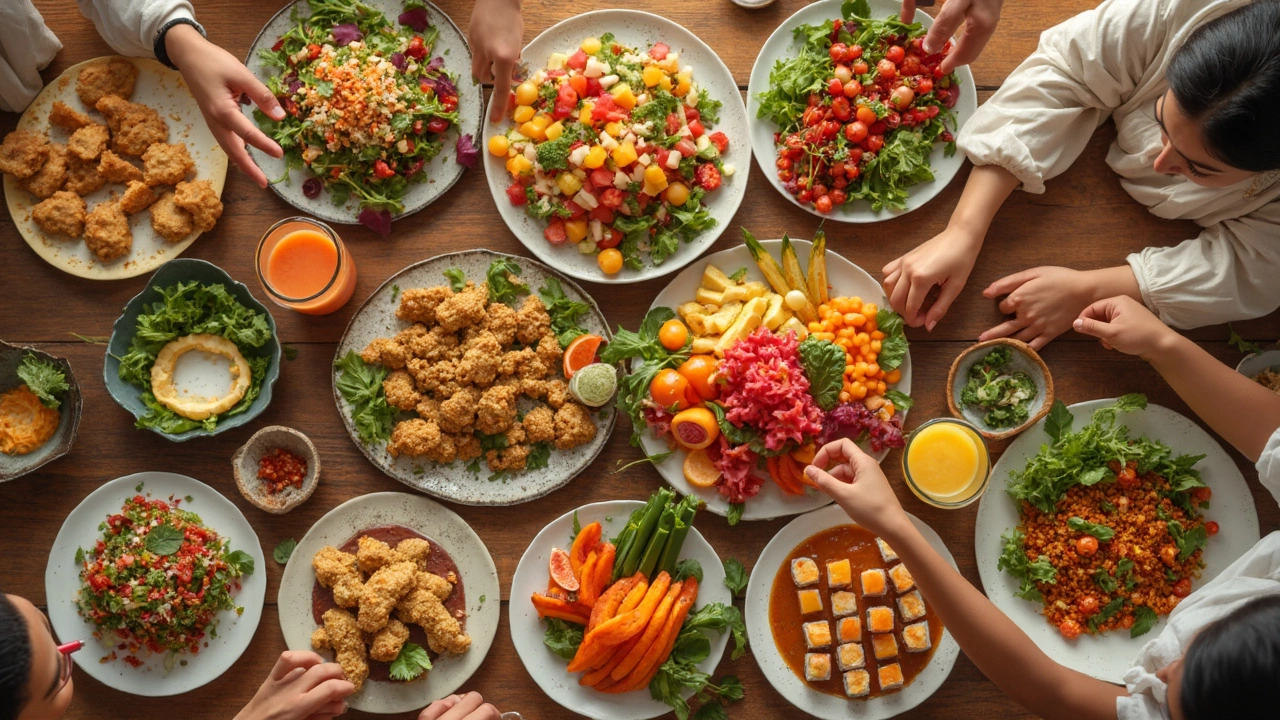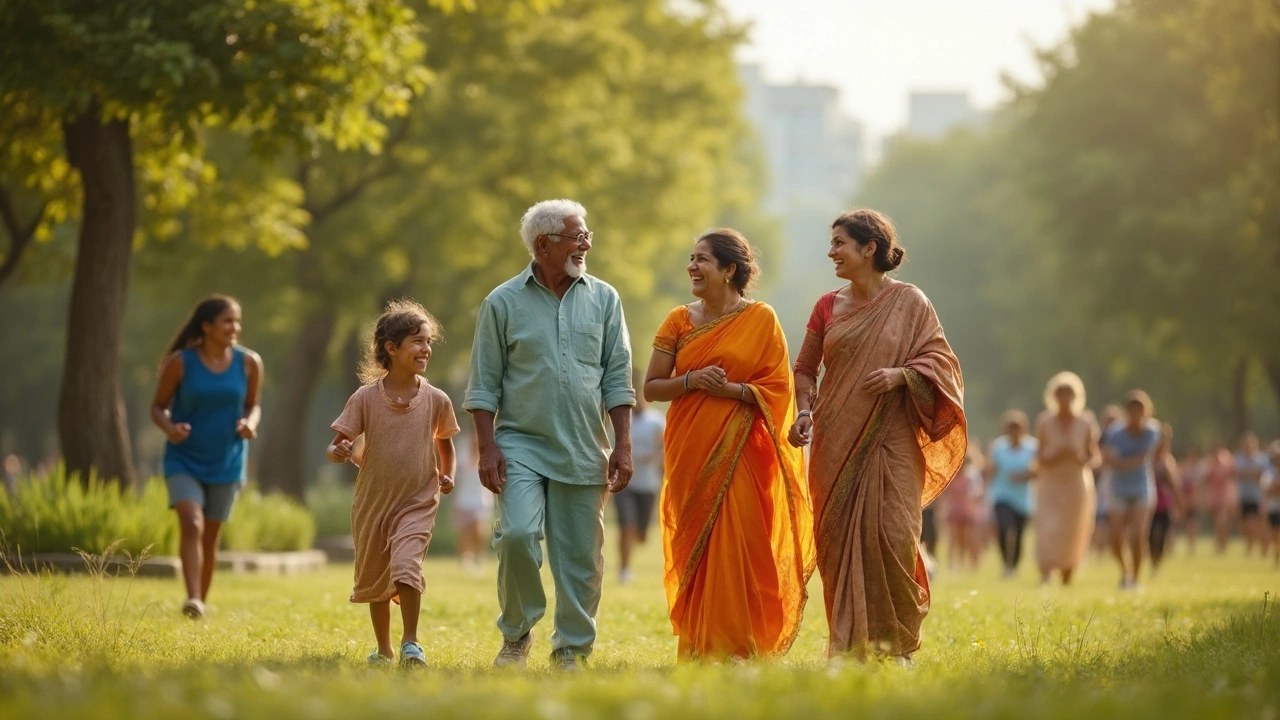
If you've ever looked at those world health charts and wondered how some countries seem to have lower rates of heart disease or people living past 100 like it's no big deal, you're not alone. Food plays a huge role, and the differences in what we eat from one country to another actually show up in real health numbers. So if you’re thinking of traveling for medical treatment, or just trying to eat better, learning from the pros (aka, countries with the healthiest diets) is a smart move.
Take the Mediterranean region, for example—Greece, Italy, and Spain. Their meals are loaded with veggies, beans, fish, and healthy fats from olive oil. Not only does it taste better than most diet food (zero rabbit food vibes), but studies keep showing that these eating habits actually lower your risk for a ton of diseases. The Japanese, on the other hand, have their own formula for health with fish, rice, and pickled veggies—plus smaller portions, which probably does more than any superfood ever could.
- Why People Compare National Diets
- Mediterranean Magic: The Gold Standard?
- Japan: Where Longevity and Food Collide
- Nordic Eating Habits: Less Talked About, Still Stellar
- What Makes a Diet 'Healthy' to Begin With?
- How Medical Tourists Can Eat Like a Local
Why People Compare National Diets
People dig into national diets for a bunch of reasons, but mostly, it’s about figuring out who’s doing it right and what that means for our own health. It’s not just curiosity—countries with lower obesity rates, fewer heart attacks, or longer lifespans are living proof that what you eat matters. That’s why healthiest diet comparisons pop up in news articles, research studies, and, lately, even on TikTok.
When you look at places like Japan and the Mediterranean region, you see sharp differences from, say, the typical American diet. Home-cooked meals, fresh ingredients, and fewer processed foods make a big impact. The goal isn’t to make a “best list” for bragging rights—it’s to see what habits we can borrow.
Medical tourists care about this, too. If you’re recovering from surgery or treatment abroad, knowing the local food can help your healing. Some countries’ traditional diets line right up with your recovery goals. Plus, seeing the clear link between diet and real health stats is a wakeup call.
| Country | Average Life Expectancy (2025) | Obesity Rate (%) |
|---|---|---|
| Japan | 84.8 years | 4.3 |
| Italy | 83.7 years | 9.8 |
| USA | 78.7 years | 36.2 |
Those numbers speak for themselves. The healthiest diet stats usually match up with better health results—longer lives, lower disease risk, and less money spent on medications. That’s the real reason people are interested: better ways to eat, and better payback in the long run.
Mediterranean Magic: The Gold Standard?
People toss around the term Mediterranean diet for good reason—it's one of the most studied eating patterns out there, and it's earned its reputation. Research in places like Italy, Greece, and Spain shows that this way of eating can drop your risk of heart disease, cut down on diabetes, and even help you live longer. According to a big study published by the New England Journal of Medicine, people following a Mediterranean style of eating had about 30% lower risk of major heart problems compared to a standard low-fat diet.
So, what exactly goes on the plate? Mediterranean meals are full of:
- Fresh veggies—tomatoes, leafy greens, peppers, you name it.
- Legumes and beans like chickpeas and lentils.
- Whole grains (think brown bread, barley, or farro).
- Fish and seafood as main proteins, chicken and eggs occasionally.
- Loads of olive oil—butter doesn’t get much love here.
- Nuts and seeds for snacking.
- Wine, but never overdoing it. Usually just a glass with dinner.
Red meat? Rarely. Sweets? Mostly at celebrations or holidays. Portion sizes tend to be small. And here’s the kicker: meals are social. You won’t find many folks eating at their desks or in a rush.
This isn’t just some trend—people around the Mediterranean region actually live this way. No wonder places like Sardinia in Italy and Ikaria in Greece are well-known for having some of the world’s oldest and healthiest populations.
| Country | Average Life Expectancy (years) | Obesity Rate (%) |
|---|---|---|
| Italy | 82 | 20 |
| Spain | 83 | 24 |
| Greece | 81 | 25 |
If you’re a medical tourist thinking about getting treated in Southern Europe, you might notice hospitals actually serve food that follows these guidelines—no mystery meat and soggy fries. Pro tip: If you want to try it at home, start swapping in more beans, olive oil, and leafy greens. Even these little changes can pay off for your health.
Japan: Where Longevity and Food Collide
Let’s get real—if you want proof that what you eat matters, just look at the numbers coming out of Japan. The country consistently ranks in the top spots for longest life expectancy. According to data from the World Health Organization, Japanese women usually outlive everyone else on the planet. Men aren’t far behind either. And yeah, it’s not just luck or good genes; a lot of it comes down to what’s actually on the plate every day.
The typical Japanese diet is loaded with fish, rice, seasonal vegetables, seaweed, and fermented foods like miso and natto. These aren’t basic health fads—they’re things people have been eating for centuries. Here’s why it works so well:
- Fish and seafood serve up healthy omega-3 fats, which help keep your heart ticking and inflammation low.
- Rice is the staple, but it’s usually eaten with plenty of fiber-rich sides, not in giant piles. This makes for balanced blood sugar and steady energy.
- Vegetables (fresh or pickled) show up in pretty much every meal, pumping up the diet with vitamins, minerals, and gut-friendly probiotics.
- Fermented foods like miso and natto aren’t just trendy—they’re great for digestion and boost immunity.
- Portion size is smaller in Japan, so it’s tough to overeat. Meals look good on the plate and don’t leave you feeling stuffed.
Another thing: Japanese people don’t eat as much processed food. Sweets and fried stuff exist, of course, but they’re not everyday staples. Most of the time, it’s a mix of whole foods, cooked simply, and eaten slowly.
Just to give you an idea of why all this matters, check out this quick table:
| Country | Average Life Expectancy (years) |
|---|---|
| Japan | 84.6 |
| USA | 77.0 |
| Italy | 83.3 |
If you’re heading to Japan for medical tourism, or even just visiting, here are a few practical tips to eat the healthy Japanese way:
- Stick to local Japanese breakfasts—grilled fish, rice, soup, and pickles. Less sugar, more balance.
- Try bento boxes, which mix proteins, veggies, and rice in perfect portions.
- Don’t skip the miso soup; it’s low-cal and high in flavor.
- Watch your portions. You’ll enjoy the meal and avoid that heavy, tired feeling after.
- Swap soda for green tea. It’s packed with antioxidants, zero sugar.
The Japanese approach to food is working—and the stats prove it. Anyone looking for the healthiest diet should definitely take notes from what’s going on in Japan.

Nordic Eating Habits: Less Talked About, Still Stellar
The Nordic countries—think Sweden, Denmark, Norway, Finland, and Iceland—don’t get as much hype as the Mediterranean or Japanese diets, but they’re killing it on the healthiest diet charts. People there focus on simple, whole foods that work with the seasons: lots of fish, root veggies, whole grains, berries, and lean meats like reindeer or game. Not exactly your standard takeout, but the stats prove it’s working.
One thing that stands out about the Nordic approach is how much they care about sustainability. It’s not just about what’s on the plate, but how it gets there. Local produce, wild-caught fish, and minimal food waste are all big deals. When you walk into a shop or home kitchen in Copenhagen or Stockholm, you’ll see rye bread, herring, and butter instead of sugar-packed snacks. Even the snacks are different—kids munch on crisp bread and fruit, not chips or soda.
There’s legit science backing this up: a 2012 Swedish study tracked people who ate what’s called a "New Nordic Diet" and found it cut out processed foods, kept blood pressure in check, and helped with healthy weight loss. Nordic countries also have some of Europe’s lowest heart disease and obesity rates, which isn’t random.
| Country | Life Expectancy | Obesity Rate (%) |
|---|---|---|
| Sweden | 83 years | 20 |
| Denmark | 81 years | 19 |
| Finland | 82 years | 22 |
Curious what a typical day looks like? It’s hearty and filling but not heavy junk. Here’s what you might see:
- Breakfast: Dark rye bread, boiled eggs, maybe a few slices of cheese
- Lunch: Open-faced sandwiches topped with smoked fish or lean meats and loads of greens
- Dinner: Baked fish, steamed root veggies like carrots and turnips, barley or potatoes on the side
- Snacks: Fresh berries, crisp bread with a dab of butter, or skyr (Icelandic yogurt)
Medical tourists heading to the Nordics usually notice how easy it is to eat clean without even trying. Locals aren’t big on sauces, fried stuff, or sugary drinks. They fill up on food that actually fills you up. Kids like my Anaya probably wouldn’t even notice the lack of cartoon-branded junk at the checkout line.
If you want to eat like a Nordic local, just stick with simple ingredients, go for more fish and veggies, and swap white bread for rye. Easy changes, big health payoff.
What Makes a Diet 'Healthy' to Begin With?
People talk a lot about healthy eating, but what does that really mean straight up? It’s not just about calories or carbs. Doctors and scientists break it down to a few basics: lots of real (unprocessed) foods, a mix of nutrients, and not overdoing it on sugar, salt, or the fatty stuff that clogs your arteries.
According to the Harvard School of Public Health, a solid healthy diet includes: “plenty of vegetables, fruits, whole grains, healthy protein sources, and healthy oils.” Sound familiar? Looks a lot like what folks in Mediterranean and Japanese food cultures actually eat.
The best diet is one that includes a rainbow of plant foods, plenty of fiber, and healthy fats, not rigid rules or the latest fad. — Dr. Walter Willett, Harvard T.H. Chan School of Public Health
If you want to spot what makes a diet healthy, check for these:
- Loads of vegetables and fruits at every meal
- Whole grains (brown rice, oats, whole wheat—none of that bleached stuff)
- Lean protein—fish, nuts, beans, chicken over bacon or sausage
- Healthy fats, like olive oil or avocados—not trans fats
- Low amounts of added sugars and highly processed junk
It’s all about balance and variety. A diet that’s mostly plants and super fresh foods is linked to less heart disease, diabetes, some cancers, and—you guessed it—living longer. Here’s a quick peek at what’s usually on the plates of top healthiest diet countries:
| Country | Main Features | Life Expectancy (years) |
|---|---|---|
| Japan | Fish, veggies, rice, small portions | 84.7 |
| Italy/Greece (Mediterranean) | Veggies, legumes, olive oil, fish | 83.6 |
| Norway | Whole grains, root vegetables, seafood | 82.8 |
Notice none of these involve cutting out entire food groups or starving—just eating more of the good stuff. If you’re chasing the healthiest diet, look for countries where eating habits tick all these boxes.
How Medical Tourists Can Eat Like a Local
Traveling for healthcare? Then you've got an amazing chance to eat like the locals and maybe even pick up habits that could change your health back home. Sticking to the healthiest diet styles abroad isn’t just about skipping fast food. It’s about understanding what, how, and when people in that country really eat.
First, don’t just rely on hotel buffets or tourist traps. These places usually serve watered-down versions of local food or a universal "safe" menu. Instead, look for smaller "mom and pop" places, street vendors, and lunch spots packed with regular folks. If the line is mostly locals, that’s usually a good sign it’s authentic and safe.
- In Japan, bento shops and sushi counters are everywhere. The portions are smaller, and the food is super fresh. If you’re in the Mediterranean, grab a salad with extra virgin olive oil, nuts, and grilled fish. Skip the creamy dressings and stick to lemon or vinegar like they do.
- Don’t be afraid to visit supermarkets. It’s a great way to see what’s really on people’s tables. In Italy, you’ll find tons of different beans, veggies, and fish—way more types than you’d ever see at a big-box store in the US.
- Ask about the daily special. Most places cook what’s fresh and in season, which is probably why locals aren’t eating strawberries in December or heavy stews in summer.
One of the smartest things you can do: try to eat at the same times as the locals. In Spain, lunch is the big meal and happens around 2 or 3 PM. In Sweden, there’s a daily fika break with coffee and a snack. Match your schedule and it’s a lot easier to find healthy, filling meals without snacking on junk.
| Country | Go-To Local Meal | Eating Tip |
|---|---|---|
| Japan | Fish, rice, pickles | Watch portion sizes and try seaweed salads |
| Greece | Greek salad, grilled fish | Use olive oil, skip the bread basket |
| Sweden | Salmon with potatoes | Add lots of veggies and rye crispbread |
| Italy | Minestrone soup, beans, whole grains | Choose water, not soda, with meals |
If you’re sensitive to new foods, start easy with cooked dishes and work your way up to raw salads and local specialties. And here’s a tip that worked for me while traveling with Anaya: bring a small bottle of hand sanitizer and maybe some plain yogurt for breakfast. It helps keep your stomach happy anywhere you go. If you want to go deeper, ask your Airbnb host or clinic staff for restaurant recommendations—they almost always know the healthy hidden gems.








